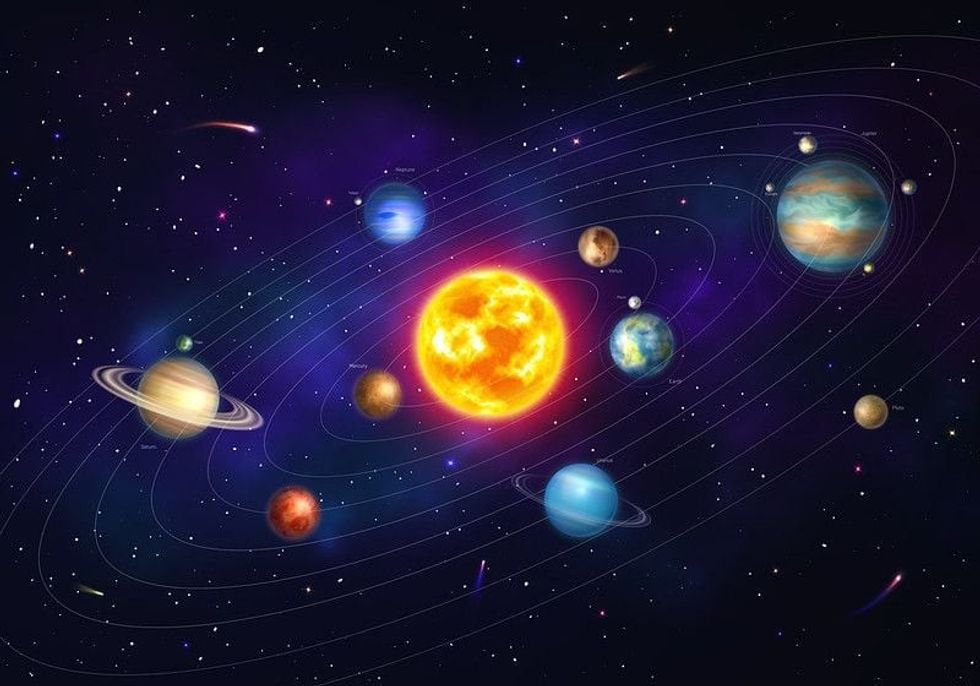All Planets' Distance From Earth In Km
Every one of the eight planets in the solar system revolves around its parent star, the Sun. None of their revolution-orbit is a perfect circle, though.
All planets go around the Sun in paths that are elliptical. So, the distance between a planet and the Sun varies slightly based on the position the planet is in along the elliptical orbit.
Since the Sun is the stationary center, and all the planets revolve around it in fixed paths, the distance between the planets and their parent star doesn't vary that significantly. The distance between two planets is a different story, though, because of their constantly changing position around the Sun.
Two planets are at their closest point when they are on the same side of the Sun and can be the most distant when they are on the opposite sides of the parent star. Hence, when talking about the distance between two planets, we use the average distance between them.
This distance is usually represented in kilometers or miles or astronomical units (AU).
The astronomical unit is the Earth's average distance from the Sun, which is approximately 93,000,000 mi (149,668,992 km). Scientists and space researchers use the astronomical unit (AU) to measure distances within the solar system.
The planet nearest to the Sun, Mercury, records a distance of 48,000,000 mi (77,248,512 km) at its nearest position to the Earth, and a distance of 138,000,000 mi (222,089,472 km) at its farthest. The average distance between Mercury and Earth, however, is 56,900,000 mi (91,571,673.6 km) or 0.61 au.
The planet second closest to the Sun is Venus. It also records the closest distance to Earth. This close positioning occurs during its inferior conjunction.
In astronomy, an inferior conjunction takes place when two planets are in a line on the same side of the Sun, and a superior conjunction happens when the inferior planet forms a line on the opposite side of the Sun with the superior planet. Mercury and Venus are the only inferior planets to the Earth.
The distance between Earth and Venus at an inferior conjunction is 23,600,000 mi (37,980,518.4 km), and the distance recorded at its farthest point from Earth is 162,000,000 mi (260,713,728 km). The average distance between the blue Earth and Venus is 25,700,000 mi (41360140.8 km) or 0.28 au. Right now, Venus is at a distance of 39,000,000 mi (62,764,416 km).
The shortest distance recorded between Earth and Mars is 33,900,000 mi (54,556,761.6 km), and the longest possible distance between these neighboring planets can be 249,000,000 mi (400,726,656 km). The average distance between Earth and the red planet is 48,600,000 mi (78,214,118.4 km) or 0.5 au.
The giant planet of Jupiter is 365,000,000 mi (587,410,560 km) away from Earth at their closest interaction and 601,000,000 mi (967,215,744 km) at the farthest. Jupiter has an average distance from Earth of 390,000,000 mi (627,644,160 km) or 4.2 au.
Saturn, the only ringed planet in our solar system, is closest to Earth at a massive distance of 746,000,000 mi (1,200,570,624 km) and farthest from our home planet at a distance of 1,000,000,000 mi (1,609,344,000 km). The average distance from Earth to Saturn is 792,000,000 mi (1,274,600,448 km) or 8.52 au.
The seventh-place planet of the Solar system, Uranus, comes closest to the Earth at a distance of 1,600,000,000 mi (2,574,950,400 km) and strays farthest from the Earth at a distance of 198,000,000,000 mi (318,650,112,000 km).
The enormous average distance recorded between Uranus and Earth is 1,700,000,000 mi (2,735,884,800 km) or 18.2 au. The last planet on the list, Neptune, the planet at the furthest distance from Earth, is closest to Earth at a distance of 2,700,000,000 mi (4,345,228,800 km) and the most distant at 2,800,000,000 mi (4,506,163,200 km) away.
The average distance between the blue planet of Neptune and our Earth is 2,700,000,000 mi (4,345,228,800 km) or 29.1 au, which makes Neptune the planet farthest from Earth.
Other than the planets of Mercury, Venus, Mars, Jupiter, Saturn, Uranus, and Neptune, Earth has several other celestial neighbors in the form of dwarf planets and asteroids in the asteroid belt between Jupiter and Mars. The dwarf planets are the smaller celestial bodies that orbit around the Sun but do not quite fit the bill to be a planet.
The former ninth planet that was part of our solar system, Pluto, is the most beloved dwarf planet for those living on planet Earth.
Ceres, the biggest body of the asteroid belt between Jupiter and Mars, is the dwarf planet nearest to Earth. The current distance between Ceres and Earth is 163,000,000 mi (262,323,072 km) or 1.76 au.
The other recognized dwarf planets Pluto, Makemake, Eris, and Haumea, are included in the Kuiper belt beyond Neptune. Pluto is at an average distance of 3,100,000,000 mi (4,988,966,400 km) or 33.5 au from the Earth.
Makemake is at a distance of 3,480,000,000 mi (5,600,517,120 km) from the Earth, and the football-shaped dwarf planet, Haumea, is at a distance of 4,700,000,000 mi (7,563,916,800 km). The farthest dwarf planet from Earth is Eris, found to be as far as 88,400,000,000 mi (142,266,009,600 km) or 95.2 au.
Now that we have learned each planet's distance from Earth, let us learn each planet's distance from the Sun, the center of everything solar.
The space between the Sun and the planets of Neptune, Uranus, Saturn, Jupiter, Mars, Earth, Venus, and Mercury stretch to average distances of 2,800,000,000 mi (4,506,163,200 km) or 30 au, 178,000,000 mi (286,463,232 km) or 19.2 au, 888,000,000 mi (1,429,097,472 km) or 9.54 au), 483,000,00 mi (77731315.2 km) or 5.2 au, 141,000,000 mi (226917504 km) or 1.52 au, 92600000 mi (149025254.4 km) or one au, 67,000,000 mi (107826048 km) or 0.72 au and 35,900,000 mi (57,775,449.6 km) or 0.39 au respectively.
How long would it take to get to all the planets from Earth?
Earth's natural satellite, the moon, is the only celestial body that human beings have landed on. Humans have sent crewless spacecraft and rovers to planets like Venus and Mars, as well as to other terrestrial objects like asteroids, moons, etc.
Though we know the distances between each planet and Earth, getting to each planet and calculating how long it would take is a complicated process. Since the planets are constantly moving, the time taken to travel to a planet from Earth will depend on the current distance between them.
Other factors that will have an impact on the travel time are the speed of the spacecraft, route taken, etc.
The timing also depends on whether you want to pass by the planet or land on it, because landing on a planet depends on a lot of factors, which is why it is such a time-consuming process. On a different note, the first spacecraft to pass by Mercury took 147 days in the 1970s.
The flyby of our neighbor planet Venus took 97 days (three months) in 1962.
For the present generation of spacecraft, it would take 120-300 days to reach Mars. A spacecraft would take between two to six years to reach the gas giant Jupiter.
The space probe Cassini, which successfully dropped a lander on Saturn's moon Titan, took nearly seven years, whereas recent flyby probes took two to two and a half years to pass the ringed planet by.
It took eight and a half years for the Voyager to fly by Uranus and 12 years to pass by the last planet, Neptune.
For the New Horizons spacecraft, it took only nine and a half years to reach our favorite dwarf planet, Pluto. This goes to show that there is no definite answer to the question 'How long will it take to reach a planet from Earth?'
As newer, more advanced space technologies keep emerging, and the planets keep changing positions, the time taken to explore our sister planets keeps changing.










